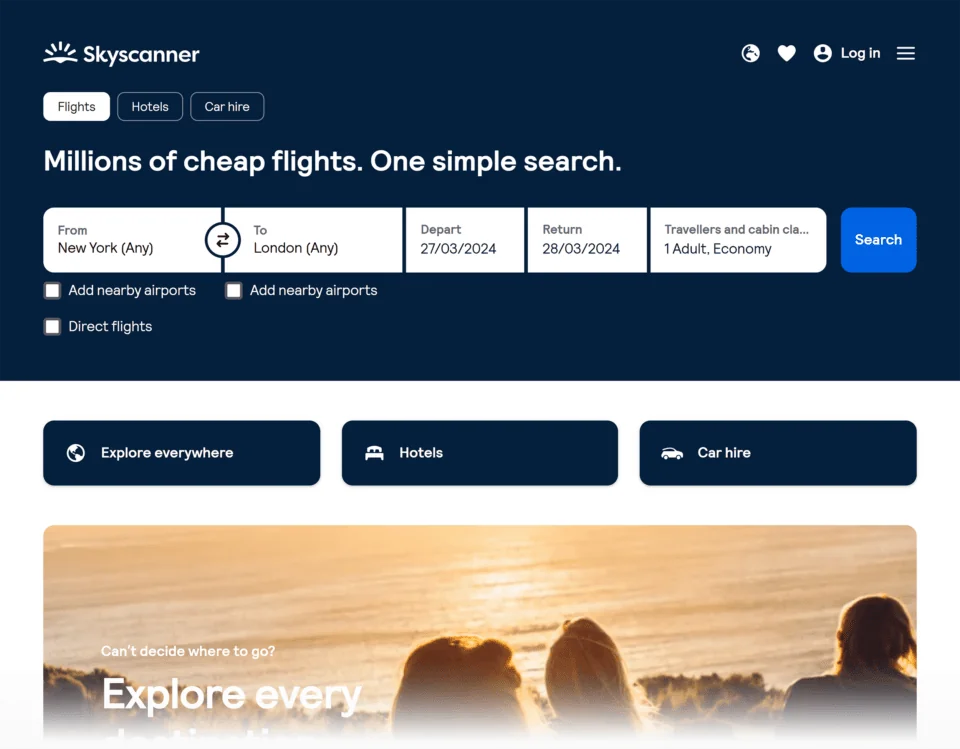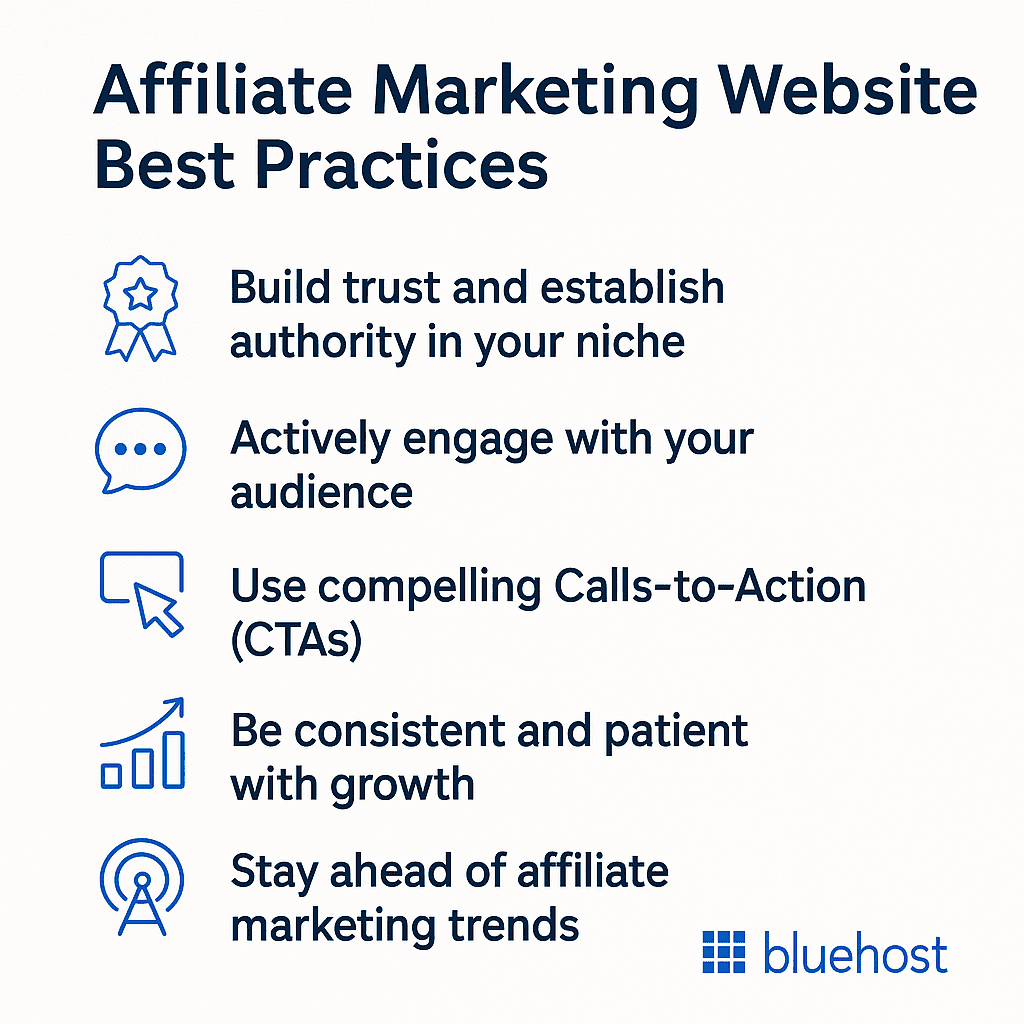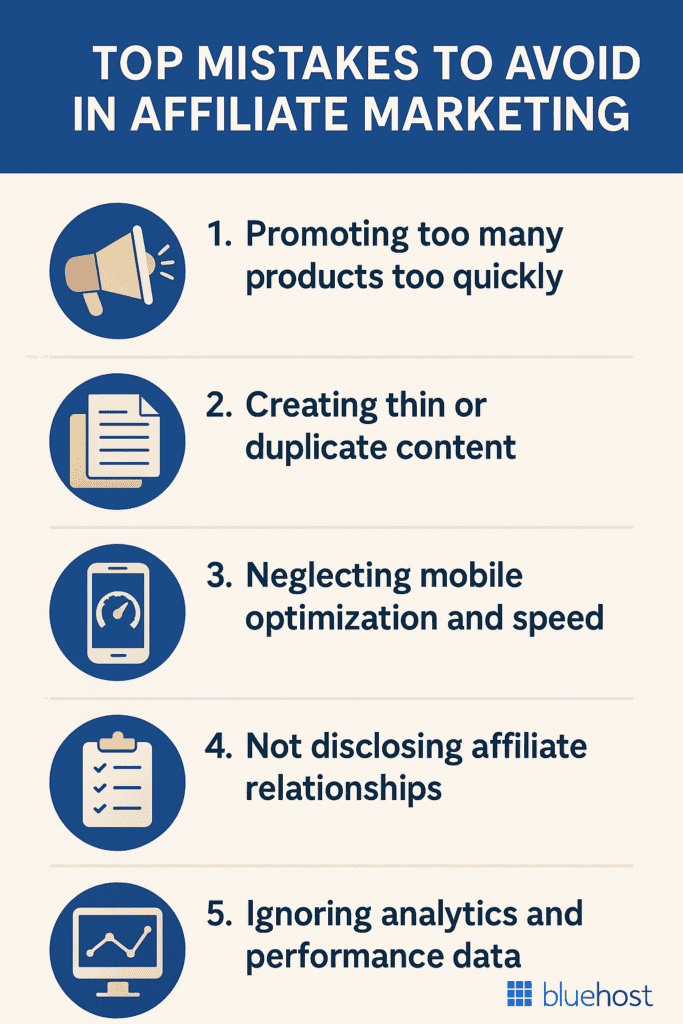Key highlights
- Learn how to build a professional affiliate marketing website from scratch using beginner-friendly tools like WordPress and Bluehost.
- Understand the step-by-step process of choosing a niche, selecting affiliate programs and setting up content that attracts targeted traffic.
- Explore practical SEO, content and marketing strategies to increase visibility, drive traffic and boost affiliate commissions.
- Know the common mistakes that hinder affiliate success and discover how to avoid them with clear, actionable advice.
- Uncover the essential plugins and tools that simplify website management, improve performance and help optimize your affiliate earnings.
You wake up, check your phone and see a message: You just earned money. No meetings, no boss. That’s passive income from your website while you sleep.
It may sound too good to be true, but thousands of affiliate marketers earn real money online by doing this. You don’t need to create products, handle support or manage inventory. Just promote affiliate products and earn through affiliate links.
But here is the catch: Before you start earning, you’ll need a professional-looking affiliate marketing website to build trust and attract your target market. If you’re wondering how to start an affiliate marketing website or looking to start an affiliate website that converts, you’re in the right place.
This guide will show you how to create a website for affiliate marketing, from setup to strategy, so you can build a successful affiliate website and start generating income. But first, let’s get a thorough understanding of what an affiliate marketing website really is.
What is an affiliate marketing website?
An affiliate marketing website enables people to promote products or services and get paid when users make purchases through those links.
Simple definition of affiliate marketing website for beginners
An affiliate marketing website promotes products or services from other companies. You earn a commission for every sale, lead or click generated through your referral links. It’s one of the most accessible and scalable methods for monetizing content online. This strategy works well for bloggers, influencers and niche site owners.
How affiliate websites work: Clicks, cookies, commissions
Affiliate marketing websites use special tracking links called affiliate links. These links monitor user activity. Here’s a breakdown:
- Click: A visitor clicks on a product link embedded in your content.
- Cookie: The merchant stores a small tracking file (cookie) in the user’s browser. This cookie has an expiration period (often 7–30 days).
- Commission: If the visitor makes a purchase within that window, you earn a commission at no additional cost to the buyer.
For example, if someone reads your review of a laptop and clicks your Amazon link, you may earn a percentage of that sale, even if they buy days later.
This performance-based model means you only earn when your referral leads to a defined action, usually a purchase or sign-up.
Common formats: Blogs, review sites, coupon hubs
Affiliate marketing websites come in many forms. Some of the most effective websites include:
- Niche blogs: Content-rich sites targeting specific interests, like tech, fitness or travel.
- Product review sites: Focused on comparing and recommending products (e.g., “best noise-canceling headphones under $200”).
- Coupon or deal hubs: Sites that collect promo codes and cashback offers, earning through clicks and redemptions.
- Resource lists or tutorials: Articles like “Top 10 tools for freelancers” that recommend affiliate products naturally.
Looking at affiliate marketing website examples in your niche can help you understand what content formats convert best. A clean design, high-quality content and strategic SEO can set your site apart as a successful affiliate marketing website.
Why start an affiliate marketing website in 2025?
Affiliate marketing remains one of the most scalable, beginner-friendly business models. In 2025, it’s more relevant than ever. Here’s why starting now gives you a major edge.
Rise of the creator economy and passion-led business
According to a report by Goldman Sachs, the creator economy is expected to reach half a trillion dollars by 2027. There is a general shift in people’s approach to their careers. More people are now leaning toward turning their hobbies into income streams by building audiences around what they love.
Whether you’re a fitness coach, gamer, travel blogger or finance expert, there’s a passionate audience looking for recommendations in your niche.
Global affiliate platform expansion and new niches
Affiliate platforms are expanding rapidly across global markets and industries.
From SaaS and online learning to sustainable goods and health tech, global affiliate networks like Amazon Associates have introduced new verticals. This has a global and localized impact. This makes it easier to join programs, track conversions and get paid across borders.
Furthermore, there is an emerging market where niche micro-communities are creating untapped affiliate opportunities. This is especially the case for multilingual and region-specific content creators.
Earn passive income with minimal startup investment.
Unlike eCommerce or service businesses, other affiliate websites don’t require inventory, customer service or large teams. You focus on driving traffic and providing value, while companies handle fulfillment.
With SEO and a strongly developed content strategy, your blog can attract traffic 24/7. High-performing posts can generate clicks and commissions automatically.
Many affiliates see their first commissions within 3–6 months of consistent publishing and audience building. However, with persistent efforts in the right direction, affiliate marketing promises a steady stream of passive income at a conservative startup investment.
We have understood why 2025 is the perfect time to start. Now, we will walk through the exact steps to build your affiliate marketing website, from setup to monetization.
How to build an affiliate marketing website: A step-by-step breakdown
Building an affiliate marketing website is easier than ever. You don’t need coding skills or a large budget to get started. With the right setup, tools and affiliate marketing strategies, you can launch a site that earns affiliate revenue and builds long-term passive income.
This quick guide explains how to launch an affiliate marketing website that attracts visitors, fosters trust and generates consistent affiliate sales.
With these 8 steps, you’ll get a comprehensive idea of how to set up an affiliate website for yourself:

Let us examine the steps one by one:
Step 1. Choose your affiliate marketing niche
Your first step into affiliate marketing is to choose the ideal niche for your business. There is no perfect niche, but a thoughtful niche choice lays the foundation for long-term success.
Start by assessing your experience, skills, hobbies and interests to generate interesting content ideas. Then, evaluate each idea by asking the following questions:
- What does the competition look like in this niche?
- Does your niche have a large enough audience to sustain traffic?
- Are there affiliate programs available for this niche?
- What are the pay and commission rates like?
- Can you create consistent and engaging content around this topic?
These considerations will help you find a niche for your blog that is both profitable and enjoyable. Remember, your niche will shape the foundation of your affiliate marketing website setup, so it’s important to pick something you’re passionate about. Since creating a website for affiliate marketing requires ongoing content and audience engagement, selecting a niche you genuinely enjoy will make the process easier and more sustainable.
Step 2. Select an affiliate marketing program that suits your style
After identifying your preferred niche, it’s time to find the right affiliate program. Sometimes, you’ll work directly with the merchant offering the affiliate product or program. However, affiliate networks are also an option for discovering thousands of brands and products that may fit your niche.
A great example is Bluehost Web Hosting Affiliate Program.

Other popular options include ClickBank, Rakuten Advertising and ShareASale.
No matter which affiliate network you join, once approved, you’ll have access to multiple products within their catalog of affiliate programs. Ordinarily, you only need a website with traffic, social media accounts and a working knowledge of marketing campaigns.
Still can’t find the program you want? Contact businesses that sell your ideal product. Many businesses are willing to onboard marketing partners and some affiliate programs may only be available on request.
Also read: Top 10 Affiliate Marketing Programs for Maximum Earnings
Step 3. Find an ideal web hosting plan and domain name
If you already have an affiliate marketing website, bravo! If you don’t, no problem. You can always create a new one from scratch.
But first, you need to buy a domain name. Are you wondering what domain names are?
A domain name serves as the address your users will type to access your new website. At Bluehost, we offer an affordable way to register a domain, making it simple to secure the perfect name for your affiliate marketing website.
Here are a few things to keep in mind while choosing your address:
- Choose a short, simple and memorable domain name that resonates with your niche.
- Opt for a .com extension when possible
- Leverage domain name generator ideas
- Register your domain with a trusted provider
Another key thing to consider is you need a hosting service to keep your website online and running smoothly. How do you choose a hosting plan?
Pick a provider that has these web hosting features:
- Specialization in WordPress for seamless web performance
- Secure and stable database services for stability
- Sufficient bandwidth and data storage plans to meet growing demands
- Uptime guarantees and backup options for smooth operations
- Secure Sockets Layer (SSL) support for encrypted, secure connections and enhanced website trust.
Step 4. Customize your website’s theme and set up plugins
Once you’ve purchased a domain and a hosting plan from a reliable hosting provider, you can set up your new WordPress site. To simplify the affiliate marketing website setup process, we offer WonderSuite, an AI website builder that seamlessly integrates with WordPress. Its intuitive tools help you quickly create and customize your site, so you can focus on monetizing your content instead of dealing with complex web development.

With WonderSuite, you can choose from a huge library of affiliate-friendly themes. Furthermore, you can utilize its drag-and-drop functionality to design an appealing affiliate marketing website with various marketing tools. You can perform this without writing a single line of code.
Additionally, it includes a comprehensive library of block patterns and page templates enriched with images and suggested pre-written copy. This simplifies how you create product reviews, landing pages and blog posts optimized for affiliate marketing.
Whether you’re a beginner or an experienced marketer, WonderSuite streamlines the process so you can launch your affiliate site faster and start earning commissions sooner.
Also read: Introducing Bluehost WonderSuite: WordPress made WONDERful
Step 5. Create content specific to your chosen niche
Next up in the affiliate marketing website setup process is content creation. Your content, along with a strong About and Contact page, is the engine of affiliate marketing success. After all, that is what attracts and engages your audience. A dedicated content creator ensures that high-quality content inspires trust and encourages visitors to explore the affiliate products and campaigns you are promoting genuinely.
One of the proven ways to create a proven track record of legitimately valuable content is through blogging. Create in-depth articles, informative blog posts, reviews and comprehensive guides that give insights into the products while also naturally incorporating affiliate links.
Beyond starting a blog, you can also explore the possibility of running a podcast, streaming video content or posting on social networks.
Step 6. Optimize your website for search engines
SEO (Search Engine Optimization) is crucial for achieving success in affiliate marketing. It helps search engines like Google discover your website. Logically, the higher your site appears in search engine rankings, the more organic visitors you will attract. With more visitors, you get higher chances of earning commissions.
This is the core of SEO. If you want your website to rank higher, your content must offer all the essential elements that match what people are searching for.
If your blog posts, reviews or guides provide helpful, relevant information, search engines will naturally position your site higher in search results. This will make it easier for potential customers to discover your affiliate recommendations.
How to improve SEO for your affiliate website
Here are the key steps involved in improving the SEO of your affiliate marketing website setup:
- Do thorough keyword research: Find out what people are searching for in your niche and include those keywords naturally in your content.
- Optimize content structure: Use headings, bullet points and short paragraphs to make your articles easy to read.
- Use SEO plugins: When it comes to SEO plugins, tools like Yoast SEO (available with Bluehost hosting) help you optimize keywords, improve readability and ensure your content meets SEO best practices.
- Focus on quality: Write in-depth, valuable content that answers users’ questions and keeps them engaged.
By following these steps and using Yoast SEO, you’ll increase your website’s visibility, drive more traffic and boost your affiliate marketing earnings.
Also read: SEO optimization checklist: Strategies to boost website authority
Step 7. Market your content across the web
To grow your affiliate revenue, you must market your website content effectively using digital marketing strategies. Here’s how to do that:
- Use social media platforms: Share your content across various channels like Facebook, Instagram, LinkedIn and TikTok. Post in groups, on your profile and in stories to reach a broader audience.
- Leverage paid ads: Platforms like Google Ads, Instagram and LinkedIn allow you to run targeted campaigns.
- Email marketing: If you have an email list, send your latest content directly to subscribers through email campaigns, keeping them engaged and driving more traffic to your site.
By incorporating these different avenues of marketing, you create a cohesive network of effective outreach.
Also read: Top High Ticket Affiliate Marketing Tips for Big Earnings in 2025
Step 8. Set up analytics to evaluate your affiliate marketing website setup

To maximize your affiliate revenue, it is essential to monitor your affiliate marketing efforts along with assessing what’s working and what’s not working. You can start by setting up analytics tools like Google Analytics. It helps you track:
- Organic traffic growth: You get an overview of how many visitors find your content naturally through search engines.
- User experience insights: You understand how visitors interact with your site, which pages they spend time on and where they drop off.
- Conversion rates: You identify which content leads to successful sales and optimize accordingly.
With the correct data, you can refine your strategy, improve your brand identity and scale your affiliate marketing success across various channels.
Now that we have learned how to build an affiliate marketing website, let us now take a look at some of the best affiliate marketing websites. We’ll examine three websites and understand what really works for them.
Top affiliate marketing website examples and why they work
Explore successful affiliate marketing sites across popular niches. These examples highlight different formats that effectively drive traffic, conversions and commissions.
Tech Niche: The Wirecutter Model

- Niche: Product reviews for domestic gadgets, tech appliances and household items.
- Estimated monthly visits: 64,800 – 70,000
- Active affiliate programs: Amazon Associates; GoPro; The Home Depot
Wirecutter is one of the successful websites where the affiliate has personally used the product or service they promote. With real experience and genuine insight, they build trust and influence, driving traffic through authentic recommendations based on firsthand use.
The Wirecutter is a prime example. It builds trust by:
- Publishing lab-tested reviews and comparisons.
- Recommending only a few top picks per category.
- Using clear CTAs like “See on Amazon” or “Best for Gamers”.
Travel niche: Skyscanner

- Niche: Travel
- Estimated monthly visits: 17.96 million
- Most active affiliate programs: British Airways and Ryanair
Skyscanner, founded in 2001, has become a trusted platform for comparing flights, hotels and car rentals. Its success lies in its powerful metasearch engine, which gathers pricing data from multiple travel sites and airlines. This lets users quickly compare options and find the best deals, simplifying the booking process across flights, accommodations and car rentals.
Skyscanner wins trust by:
- Offering travel guides and tools like “Flight Deals,” and “Cheapest Month” to help users plan smarter trips
- Embedding affiliate links to flight bookings, hotel reservation and car rental services through partner platforms
- Employing price comparison tools across major airlines and travel sites in real-time
Home security niche: SafeWise

- Niche: Home security
- Estimated monthly visits: 1.90 million
- Most active affiliate programs: Amazon Associates and CJ Affiliates
SafeWise understands the challenges its audience faces, which is why it offers detailed brand comparisons, safety manuals and reviews on key safety features. What makes its content especially user-friendly is the clear summary placed at the top of each blog post. This allows readers to quickly access the most essential information without having to scroll through the entire article in search of answers.
SafeWise wins trust by:
- Conducting rigorous, transparent product evaluations.
- Offering comprehensive safety resources across various categories.
- Being transparent about affiliate relationships.
What makes these examples effective?
These affiliate marketing powerhouses are successful because they follow a clear structure, solve real user problems and guide decisions:
- Focused intent: Each page answers a specific question (e.g., “Best camera for travel”)
- Clear value: Tools, charts or expert insights help users make confident decisions
- Minimal distractions: Professional-looking websites with clean layouts and strong calls-to-action
- Trust-building: Evidence, reviews or author expertise increases credibility
- User-first design: Content loads fast, adapts to mobile and prioritizes readability
Now that we have looked at 3 of the best affiliate marketing websites, let us veer towards alternatives to make one for your own. This is where we get acquainted with our comprehensive solutions that cater to wide-ranging affiliate marketing website needs.
What makes WordPress and Bluehost the ultimate affiliate marketing power duo?
The best affiliate marketing websites need a platform that supports fast setup, reliable performance and seamless growth. WordPress combined with Bluehost offers everything you need to launch and scale an affiliate website, whether you’re a beginner or a seasoned pro.
At Bluehost, we make it easy to get started. With one-click WordPress installs, free domain registration, built-in SSL and a beginner-friendly dashboard, you can publish your affiliate site in minutes. You also get access to affiliate-optimized themes and essential plugins from the Bluehost Marketplace, helping you reduce costs while increasing performance.
Affiliate marketers worldwide trust this setup for its simplicity, scalability and access to tools that drive conversions and revenue.
Bluehost Marketplace: One dashboard, all the tools you need
The Bluehost Marketplace gives affiliate marketers a centralized platform to install powerful WordPress plugins for SEO, link tracking, performance and email marketing.
Instead of searching and configuring tools separately, you can access everything from one intuitive dashboard. This ensures better compatibility and less time troubleshooting plugin issues, so you can focus on growing your affiliate income.
It’s the perfect starting point for beginners learning how to create a WordPress affiliate site with essential tools built right in.
Yoast SEO: Boost visibility and optimize for search
When it comes to improving search rankings with real-time guidance on keywords, meta descriptions and content readability, Yoast SEO is a go-to option for affiliate marketers.
The plugin supports schema markup, social sharing previews and internal link recommendations. It ensures that each blog post is fully optimized for search engines.
By using Yoast, you use your knowledge of SEO basics for affiliate marketing and attract traffic that converts. This makes it a foundational tool in your affiliate marketing stack.
Pretty links: Branded URLs and click tracking made easy
Affiliate links often look long and messy. Pretty Links lets you shorten, cloak and brand your affiliate URLs. This creates a more professional appearance and builds audience trust.
You also gain access to click tracking and analytics, which allow you to measure which links perform best and refine your affiliate strategies accordingly.
With Pretty Links, every link becomes a data-driven opportunity to increase affiliate revenue.
CreativeMail: Automate affiliate email campaigns
Email remains one of the most powerful affiliate marketing channels. CreativeMail lets you automate newsletters, product updates and loyalty programs directly from WordPress.
Affiliate marketers can use this tool to nurture returning visitors, build brand loyalty and drive repeat commissions.
Whether you’re promoting seasonal offers or evergreen content, CreativeMail helps you stay connected with your audience.
WonderSuite: Launch a high-converting affiliate site without code
Being a no-code builder, WonderSuite helps affiliate marketers design high-converting landing pages using modern, responsive templates.
With drag-and-drop functionality, you can build professional-looking product pages, email opt-ins and affiliate funnels without hiring a developer.
This tool is perfect for beginners who want to create an affiliate marketing website that looks great and performs even better.
Here are some best practices for building a high-converting affiliate site.
Best practices for building a successful affiliate website
To stand out in affiliate marketing, your website needs more than just product links. Here are proven best practices to help you attract traffic, build trust and increase revenue.

1. Build trust and establish authority in your niche
Success starts with credibility. Focus on becoming a go-to source in your chosen niche:
- Share well-researched, timely and factual content.
- Address common pain points with actionable solutions.
- Write in a tone that demonstrates expertise and empathy.
Over time, this builds a loyal audience that trusts your recommendations.
2. Actively engage with your audience
Engagement helps you understand your users’ needs while fostering community:
- Use social media platforms to spark conversations and get feedback.
- Reply to comments, DMs and emails to build rapport.
- Host Q&A sessions or polls to uncover new affiliate opportunities.
Listening to your audience often leads to unexpected niches and profitable ideas.
3. Use compelling Calls-to-Action (CTAs)
Your CTAs should motivate clicks without feeling pushy:
- Highlight exclusive deals, limited-time offers or benefits.
- Use language that taps into curiosity or urgency.
- Experiment with CTA placement to see what performs best.
You must create attractive CTAs that convert and help users discover more products.
4. Be consistent and patient with growth
Affiliate marketing is a long game. Sustainable success requires:
- Publishing valuable content regularly.
- Testing what works, adjusting what doesn’t.
- Staying committed even if growth feels slow initially.
With persistence, your traffic, commissions and brand authority will increase.
5. Stay ahead of affiliate marketing trends
Trends open doors to emerging product categories and new audiences:
- Follow industry blogs, newsletters and forums.
- Track trending products on social media platforms.
- Be ready to pivot your content to ride popular waves.
Early adoption can give you a competitive advantage and higher returns.
Now that we have learned about the best practices, let us look at the common mistakes in affiliate marketing that should be avoided.
What are the common mistakes affiliate marketers should avoid?
Starting an affiliate marketing journey without a clear strategy often leads to avoidable mistakes. These errors can limit your traffic, reduce revenue and damage trust. Let’s explore the most common pitfalls and how to avoid them effectively.

1. Promoting too many products too quickly
Many beginners make the mistake of promoting multiple affiliate products right away. While enthusiasm is great, promoting too many offers can overwhelm your audience and dilute your message.
What to do instead:
Start by selecting a few reliable affiliate programs that closely align with your niche. Focus on high-converting products that deliver real value to your readers. Successful affiliate marketers often build trust by maintaining focus and offering helpful recommendations, not just ads.
2. Creating thin or duplicate content
Affiliate websites filled with duplicate content or shallow posts rarely perform well. Google and other search engines prioritize original, informative content that solves user problems.
Best practice:
Invest time in writing unique product reviews, in-depth comparisons and helpful tutorials. These content types attract organic traffic, improve time on site and encourage conversions. Avoid copy-pasting product descriptions or relying solely on AI-generated blurbs without editing.
3. Neglecting mobile optimization and speed
Your affiliate website should be mobile optimized for a better experience. Poor mobile experience is a silent revenue killer in affiliate marketing. A site that loads slowly or doesn’t display correctly on phones leads to high bounce rates and lost affiliate income.
How to fix it:
Ensure your website uses a responsive design and is optimized for fast loading. Test your site speed regularly and compress images to boost performance. A mobile-friendly experience supports better search rankings and higher conversion rates across devices.
4. Not disclosing affiliate relationships
Failing to disclose affiliate links can undermine trust and even violate legal guidelines, including FTC regulations.
Key tip:
Always disclose affiliate partnerships clearly near your links. Use simple, transparent language such as “This post contains affiliate links. If you click and buy, we may earn a commission at no extra cost to you.” This builds trust with readers and protects your reputation.
5. Ignoring analytics and performance data
Affiliate marketers who don’t track performance miss key growth opportunities. Without analytics, you won’t know which pages convert or which affiliate products drive revenue.
What to track:
Use tools like Google Analytics and affiliate dashboards to measure traffic, click-through rates and conversions. Analyze which blog posts generate the most revenue and refine your strategy accordingly. Data-driven decisions are critical for long-term success.
Final thoughts
Affiliate marketing is more than just a way to make extra money — it’s one of the most effective ways to build long-term affiliate income and grow a successful affiliate marketing website. It’s not only about earning commissions but also about creating a sustainable online business. Every good affiliate marketer begins with one key step: creating a website. And that’s where Bluehost can help.
Bluehost makes starting an affiliate marketing website simple, whether you’re learning how to create a website for affiliate marketing or planning to start an affiliate website to promote your favorite affiliate products.
Bluehost offers:
- Simple WordPress setup with WonderSuite for easy website changes.
- Quick and dependable hosting to keep your site up and running 24/7.
- Included SEO tools like Yoast SEO, which help you get more visitors.
Finding a way to earn money online has never been easier. With Bluehost, you’ll have everything you need, from website builder tools to marketing plugins, to grow a successful affiliate marketing website. Additionally, you can add affiliate links and increase affiliate revenue through valuable content and promoting affiliate products.
So, why wait? Start affiliate marketing today and create your website with Bluehost to begin your affiliate marketing journey toward long-term passive income and successful sales.
FAQs
The cost typically ranges between $50 to $200 per year for hosting and a domain, plus $20 to $50 per month for maintenance. Bluehost offers affordable shared hosting with a free domain for the first year.
Yes, you can make $100 a day with affiliate marketing. It requires the right niche, quality traffic and consistent promotion of high-converting offers. Success depends on your strategy, effort and optimization over time.
WordPress is the best platform due to its flexibility, SEO-friendliness and vast selection of themes and plugins tailored for affiliate marketing.
No, but it requires patience and consistency. Learning SEO, content creation and marketing strategies takes time, but it’s manageable with the right tools and effort.
Typically, 3 to 6 months, depending on your niche, SEO strategy and traffic growth. Some may take a year to achieve steady earnings.
Here are some of the proven ways to effectively drive organic traffic to your affiliate marketing website:
SEO-optimized content to rank on search engines
Social media marketing to reach a broader audience
Email marketing to engage and retain visitors
Paid ads (Google, Facebook, Instagram) for targeted reach
Below are some of the ways you can increase the conversion rate of your affiliate marketing website
Use clear CTAs to guide visitors toward purchases
Optimize page speed & user experience for seamless navigation
Write in-depth, value-driven content to build trust
Test different layouts & strategies (A/B testing) to improve performance
Selecting the right affiliate marketing niche is crucial for long-term success. Focus on topics you’re passionate about and that have proven demand. Use keyword research and search engine optimization tools to identify profitable niches with low competition and steady interest from internet users.
Yes, maintaining an affiliate blog with consistent high-quality content can help you attract organic traffic and establish authority in your niche. Regular blog posts allow you to create engaging content, share reviews, tutorials and guides that promote affiliate products and boost affiliate sales through your unique affiliate links.
Absolutely. Many affiliate marketers join multiple affiliate programs to diversify their affiliate income and discover which affiliate partnerships perform best. When you promote products across different affiliate networks, ensure each one complements your audience’s interests and aligns with your affiliate marketing strategies for a successful affiliate marketing website.



Write A Comment